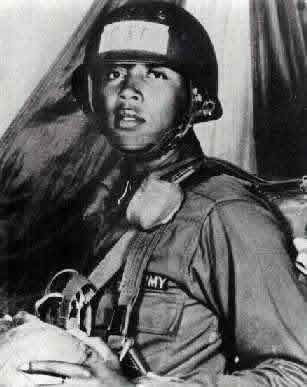In 1965, Milton L. Olive III, a United States Army soldier was the first African American to receive the Medal of Honor in the Vietnam War.
On this day October 22nd, in African American History
In 1965, Milton L. Olive III, a United States Army soldier was the first African American to receive the Medal of Honor in the Vietnam War. The Medal of Honor, America’s highest military decoration was posthumously awarded to Olive for sacrificing his life for his fellow soldiers at age 18. Part of the Congressional Medal of Honor Citation reads:
“Pfc. Olive and four other soldiers were moving through the jungle together when a grenade was thrown into their midst. Pfc. Olive saw the grenade, and then saved the lives of his fellow soldiers at the sacrifice of his own by grabbing the grenade in his hand and falling on it to absorb the blast with his body.”
Private First-Class Olive was born on November 7, 1946, in Chicago, Illinois. Olive joined the military at age 17 and was serving in Vietnam as a part of Company B of the 2nd Battalion (Airborne), 503rd Infantry Regiment, 173rd Airborne Brigade.
He died in the jungle area in Phu Cuong. His act of heroism, sacrifice, bravery and love for his fellow soldiers is beyond most of society's comprehension. Olive is buried in Lexington, Holmes County, Mississippi, the area where he lived as a young boy through high school. (Black History Today, 2019)
In 1936, Bobby Seale was born in Dallas, TX. He is an African American political activist co-founder and national chairman of the Black Panther Party and author. Robert George Seale was the oldest of three children and grew up in California. Seale joined the U.S Air Force in 1955 but was discharged in 1959 following an altercation with a superior officer. From there he attended Merritt College, in Oakland, Calif.
There his community activism took root in 1962, when he first heard Malcolm X speak. Seale helped found the Black Panthers in 1966. Noted for their aggressive views, they also ran medical clinics and served free breakfasts to schoolchildren, among other programs.
In 1969 Seale was indicted in Chicago for conspiracy to incite riots during the Democratic national convention the previous year. The court refused to allow him to have his choice of lawyer. When Seale repeatedly rose to insist that he was being denied his constitutional right to counsel, the judge ordered him bound and gagged.
He was convicted of 16 counts of contempt and sentenced to four years in prison. In 1970–71 he and a codefendant were tried for the 1969 murder of a Black Panther suspected of being a police informer. The six-month-long trial ended with a hung jury. Seale was one of a generation of young African American activist who broke away from the traditionally nonviolent Civil Rights Movement to preach a doctrine of black empowerment.
Following the dismissal of murder charges against him in 1971, Seale somewhat moderated his more militant views and devoted his time to effecting change from within the system. Following his release from prison, Seale renounced violence as a means to an end and announced his intention to work within the political process.
He ran for mayor of Oakland in 1973, finishing second. As the Black Panther Party faded from public view, Seale took on a quieter role, working to improve social services in black neighborhoods and to improve the environment. Seale’s writings include such diverse works as Seize the Time (1970), a history of the Black Panther movement, A Lonely Rage in 1978 and Barbeque’n with Bobby (1988), a cookbook.
In 2002, Seale moved back to Oakland to work with young political activists to spark social change. He has been married twice and has two children. (African American Registry, 2019)












Comments
Post a Comment